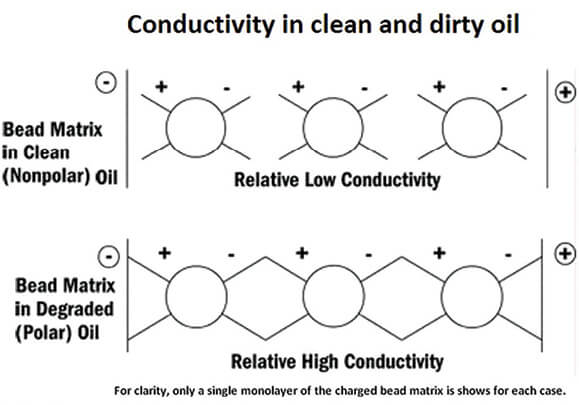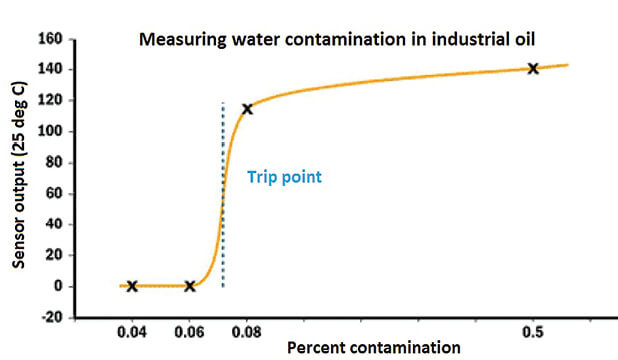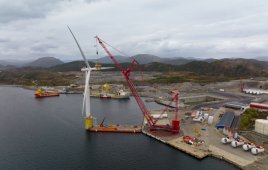Brian Steuer / Director of Business Development / Voelker Sensor Inc.
Reducing oil maintenance expenses and minimizing equipment downtime is of major interest to operators of wind turbines and industrial equipment. Periodic oil analysis, one way to reduce maintenance, can extend the life of equipment in excess of three times the normal or historic average. In addition, the cost of replacing equipment can be reduced by 50% or more. Opportunities for minimizing equipment failure, reducing the cost of analysis, and automating oil maintenance provide the need for developing an oil-condition sensor that operates in real time.

Interactions between the charged groups adjust as the oil moves from a
nonpolar (clean) condition to a polar (oxidized or water contaminated) condition.
The Oil Sentinel is one such sensor that installs directly into gearboxes or industrial processing equipment to continuously monitor the quality of oil and hydraulic fluids. In addition to offering significant advantages to planned equipment maintenance, the device provides preventive advantages as well. The sensor’s continuous monitoring capability can detect problems before they become catastrophic, such as cooling system failures, leaks, and the use of incompatible fluids. Using proprietary technology, the sensor eliminates the two-step process of sampling and lab analysis, and directly measures four oil parameters important to gearbox maintenance: water contamination, oxidation, temperature, and level.
The trip point for water contamination is triggered at levels above 0.06% by volume, depending on the oil’s saturated relative humidity (SRH). The trip point for oxidation is adjusted according to the composition of the oil and is correlated with the acid number (TAN) measurements at levels as low as 0.2 acid number units. An over-temperature detector compares the oil temperature in the reservoir to the ambient temperature to prevent excessive heat from damaging equipment. In addition, a level indicator ensures proper lubrication by monitoring the oil supply. The device consists of a sensing element, a mechanical interface (that secures to the oil reservoir) and a signal-conditioning unit with an easy-to-read LED that displays the condition of the oil.
How it works

The graph plots the results of detecting water in an oil-water mixture using the Oil Sentinel sensor.
The Oil Sentinel uses a patented technique that employs a polymeric bead matrix (held between two conducting permeable surfaces) containing charged groups that serve as a conducting medium for measuring the oil’s solvent properties. The method operates by correlating a relative change in the electrical properties of the beads with a relative change in the solvent properties of an oil.
In other words, the interactions between the charged groups adjust as the oil moves from a nonpolar (clean) condition to a polar (oxidized or water contaminated) condition.
Water can be detected as droplets, as an emulsion or fully dissolved. Oxidation, which occurs because of thermal decomposition in superheated areas of industrial processing equipment, is measured independently of water. The method does not require external standards, is independent of an oil viscosity and is compatible from 20 to 70°C (as measured in the reservoir).
Results
The accompanying plots provide a graphical representation of water contamination and oxidation measurements with the new sensor. Results are compared with standard laboratory techniques.

The graph illustrates the sensor’s oxidized oil measurements and compares them with the acid number (AN) measurements.
The test oil was treated with deionized water as a percent of volume to simulate a contaminated condition. The oil-water emulsion was mixed with a high-speed blender and the percent-water content was confirmed using Karl Fisher titration methods. Results show that above the SRH, the sensor detects the free water and triggers a response. Additional water provides an incremental change to the signal.
The oils plotted in Correlating oxidation were artificially aged at elevated temperatures to simulate oxidized conditions. Data was measured using three industrial oils: general purpose hydraulic oils (HL-32), spindle oils (FC-22) and antiwear hydraulic oils (HM-32). A plot of the data shows a linear correlation between sensor output and AN measurements that demonstrate the independence of viscosity and composition.
Benefits
Predictive and proactive maintenance of industrial machinery is a proven strategy in extending equipment life and reducing downtime. Current practices involve periodic sampling and analysis by external labs.
This service costs from $30 to $50 per sample (depending on the scope of the test) with a typical minimum turnaround time of 48 hours. In most cases, these tests come back negative, indicating an acceptable level of oil quality and introducing additional cost into the maintenance cycle. Disposal fees add further to the service costs. In the end, this form of monitoring provides at best a snapshot at the instant the sample is taken and often does not consider recent changes in the condition of equipment or the number of duty cycles.
By contrast, the Oil Sentinel provides a method for continuous, oil-condition monitoring with an easy-to- read LED display, or by remote monitoring. This method allows combining the conventional two-step approach of oil monitoring (sampling and analysis) into a single, more efficient step. Optimizing oil monitoring provides an effective means of automating the process and managing service costs, warranty expenses, catastrophic events, disposal fees, and environmental demands.
Filed Under: Featured, Sensors





